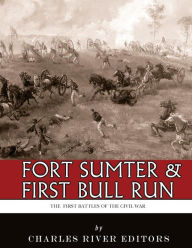Fort Sumter & First Bull Run: The First Battles of the Civil War Charles River Editors Author
Fort Sumter & First Bull Run: The First Battles of the Civil War Charles River Editors Author
*Includes pictures of important people, places, and events. *Includes maps of the battles. *Includes accounts of the fighting at Fort Sumter and First Bull Run by important generals and leaders who fought there. *Includes a Bibliography for further ...
Read more
*Includes pictures of important people, places, and events. *Includes maps of the battles. *Includes accounts of the fighting at Fort Sumter and First Bull Run by important generals and leaders who fought there. *Includes a Bibliography for further reading. After the Southern states seceded and formed the Confederacy in the wake of Abraham Lincoln's election, Americans on both sides waited anxiously to see if the North would fight to preserve the Union. The Confederacy's hope of being let go in peace ended at 4:30 a.m. on the morning of April 12, 1861, when Confederate Brigadier-General P.G.T. Beauregard ordered the first shots to be fired at the federal garrison defending Fort Sumter in the Charleston Harbor, effectively igniting the Civil War. For nearly 36 hours, Beauregard's Confederates unleashed a general bombardment from 43 guns and mortars positioned at various points across the Harbor. Unable to effectively reply or defend themselves, Major Robert Anderson raised the white flag early in the afternoon of April 13, bringing the first battle of the Civil War to a close. No casualties were suffered on either side during the dueling bombardments across Charleston Harbor, but ironically two U.S. Army soldiers were killed by an accidental explosion during the surrender ceremonies. Fort Sumter is popularly remembered today as the first fighting of the Civil War, and a relatively painless battle at that, but much of the history before April 12 that led to the shelling of the fort is often overlooked. The federal garrison had been stationed there months before the fight, carefully watching the secession of South Carolina, the buildup of Confederate forces in the region, and the actions of the Buchanan Administration and incoming Lincoln administration in the weeks leading up to the bombardment. After Fort Sumter, the Lincoln Administration pushed for a quick invasion of Virginia, with the intent of defeating Confederate forces and marching toward the Confederate capitol of Richmond. Lincoln pressed Irvin McDowell to push forward. Despite the fact that McDowell knew his troops were inexperienced and unready, pressure from the Washington politicians forced him to launch a premature offensive against Confederate forces in Northern Virginia. As the first major land battle of the Civil War, the First Battle of Bull Run made history in several ways. McDowell's army met Fort Sumter hero P.G.T. Beauregard's Confederate army near the railroad junction at Manassas on July 21, 1861, just 25 miles away from Washington D.C. Many civilians from Washington came to watch what they expected to be a rout of Confederate forces, and for awhile it appeared as though that might be the case, but Confederate reinforcements, some of which arrived by train in the middle of the battle, evened up the armies' strength and turned the tide, causing the Union army to panic and break in a rout back to Washington. Today First Bull Run is remembered as the first important land battle of the Civil War, but with over 350 killed on each side, it was the deadliest battle in American history to date, and both the Confederacy and the Union were quickly served notice that the war would be much more costly than either side had believed. Fort Sumter & First Bull Run comprehensively covers all of the events that led up to the the two historic battles, the fighting that took place, and their aftermath and legacies. Along with pictures and a Bibliography, you'll learn about the Civil War's first battles like you never have before.
Less





